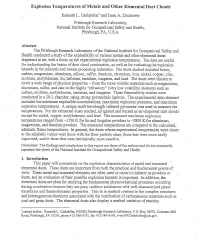Mining Publication: Explosion Temperatures of Metals and Other Elemental Dust Clouds
Original creation date: August 2006
Authors: KL Cashdollar, IA Zlochower
NIOSHTIC2 Number: 20031124
Proceedings of the Sixth International Symposium on Hazards, Prevention, and Mitigation of Industrial Explosions (Halifax, NS, Canada, Aug. 27 - Sept. 1, 2006), Halifax, Canada: Dalhousie University, 2006 Aug; 1:98-113
The Pittsburgh Research Laboratory of the National Institute for Occupational Safety and Health conducted a study of the explosibility of various metals and other elemental dusts dispersed in air, with a focus on the experimental explosion temperatures. The data are useful for understanding the basics of dust cloud combustion, as well as for evaluating the explosion hazards in the minerals and metals processing industries. The dusts studied included boron, carbon, magnesium, aluminum, silicon, sulfur, titanium, chromium, iron, nickel, copper, zinc, niobium, molybdenum, tin, hafnium, tantalum, tungsten, and lead. The dusts were chosen to cover a wide range of physical properties - from the more volatile materials such as magnesium, aluminum, sulfur, and zinc to the highly "refractory" (very low volatility) elements such as carbon, niobium, molybdenum, tantalum, and tungsten. These flammability studies were conducted in a 20-L chamber, using strong pyrotechnic ignitors. The experimental data obtained included the minimum explosible concentrations, maximum explosion pressures, and maximum explosion temperatures. A unique multiwavelength infrared pyrometer was used to measure the temperatures. For the elemental dusts studied, all ignited and burned as air-dispersed dust clouds except for nickel, copper, molybdenum, and lead. The measured maximum explosion temperatures ranged from -1 550 K for tin and tungsten powders to -2800 K for aluminum, magnesium, and titanium powders. The measured temperatures are compared to the calculated, adiabatic flame temperatures. In general, the dusts whose experimental temperatures were closer. to the adiabatic values were those with the finer particle sizes, those that were more easily vaporized, and/or those that were intrinsically more reactive.

NIOSHTIC2 Number: 20031124
Proceedings of the Sixth International Symposium on Hazards, Prevention, and Mitigation of Industrial Explosions (Halifax, NS, Canada, Aug. 27 - Sept. 1, 2006), Halifax, Canada: Dalhousie University, 2006 Aug; 1:98-113
- Coal-Dust Explosion Tests in the Experimental Mine 1919 to 1924, Inclusive
- Experimental Mine and Laboratory Dust Explosion Research at NIOSH
- Explosion Pressure Design Criteria for New Seals in U.S. Coal Mines
- Explosion Temperatures and Pressures of Metals and Other Elemental Dust Clouds
- Progress Toward Improved Engineering of Seals and Sealed Areas of Coal Mines
- Rapid (Grab) Sampling During Full-scale Explosions - Microscopic and Analytical Evaluation
- Rock Dusting Considerations in Underground Coal Mines
- Technology News 489 - Reducing the Danger of Explosions in Sealed Areas (Gobs) in Mines
- Technology News 515 - Float Coal Dust Explosion Hazards
- Technology News 535 - NIOSH Releases New Educational Video: Escape from Farmington No. 9: An Oral History